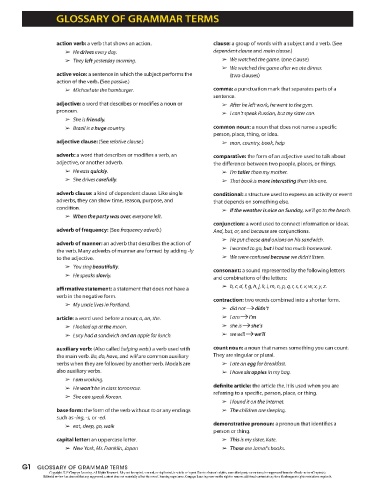Page 482 - Grammar_Explorer_3_Amy_Cooper_&_Samuela_Eckstut_Didier1_1 (1)_Neat
P. 482
action verb: a verb that shows an action. clause: a group of words with a subject and a verb. (See
> He drives every day. dependent clause and main clause.)
> They left yesterday morning. > We watched the game. (one clause)
> We watched the game after we ate dinner.
active voice: a sentence in which the subject performs the (two clauses)
action of the verb. (See passive.)
> Michael ate the hamburger. comma: a punctuation mark that separates parts of a
sentence.
adjective: a word that describes or modifies a noun or > After he left work, he went to the gym.
pronoun.
> Ican’t speak Russian, but my sister can.
> She is friendly.
> Brazil isa huge country. common noun: a noun that does not name a specific
person, place, thing, or idea.
adjective clause: (See relative clause.) > man, country, book, help
adverb: a word that describes or modifies a verb, an comparative: the form of an adjective used to talk about
adjective, or another adverb. the difference between two people, places, or things.
> He eats quickly. > I'mtaller than my mother.
> She drives carefully. > That book is more interesting than this one.
adverb clause: a kind of dependent clause. Like single conditional: a structure used to express an activity or event
adverbs, they can show time, reason, purpose, and that depends on something else.
condition.
> Ifthe weather is nice on Sunday, we'll go to the beach.
> When the party was over, everyone left.
conjunction: a word used to connect information or ideas.
adverb of frequency: (See frequency adverb.) And, but, or, and because are conjunctions.
> He put cheese and onions on his sandwich.
adverb of manner: an adverb that describes the action of
> Iwanted to go, but! had too much homework.
the verb. Many adverbs of manner are formed by adding -/y
to the adjective. => We were confused because we didn’t listen.
> You sing beautifully.
consonant: a sound represented by the following letters
> He speaks slowly.
and combinations of the letters:
0,
> 6.64,6g,h, B, G5, VW, X,Y, Z.
5,
KL,
affirmative statement: a statement that does not havea
verb in the negative form.
contraction: two words combined into a shorter form.
= My uncle lives in Portland.
> didnot— didn't
= fam—I'm
article: a word used before a noun; a, an, the.
> |looked up at the moon. > sheis—> she’s
> we will—> we'll
> Lucy had a sandwich and an apple for lunch.
auxiliary verb: (Also called helping verb.) a verb used with count noun: a noun that names something you can count.
the main verb. Be, do, have, and wilf are common auxiliary They are singular or plural.
verbs when they are followed by another verb. Modals are > fate an egg for breakfast.
also auxiliary verbs. > Ihave six apples in my bag.
= lam working.
definite article: the article the. It is used when you are
> He won't be in class tomorrow.
referring to a specific, person, place, or thing.
> She can speak Korean.
> | found it on the Internet.
base form: the form of the verb without fo or any endings > The children are sleeping.
such as -ing, -s, or -ed.
demonstrative pronoun: a pronoun that identifies a
> eat, sleep, go, walk
person or thing.
capital letter: an uppercase letter. > This is my sister, Kate.
> New York, Mr. Franklin, Japan > Those are Jamal's books.
G1 GLOSSARY OF GRAMMAR TERMS
Copyright 2015 Cengage Learning. All Rights Reserved. May not be copied, scanned, or duplicated, in whole or in part. Due to electronic rights, some third party content may be suppressed from the eBook and/or eChapter(s).
Editorial review has deemed that any suppressed content does not materially affect the overall learning experience. Cengage Learning reserves the right to remove additional content at any time if subsequent rights restrictions require it.

